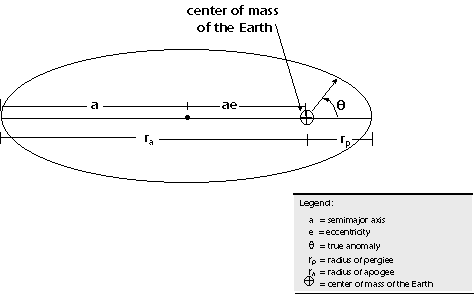Orbit Size & Shape | Orbit Orientation | Satellite Location
Classical (Keplerian) Coordinate Type
The Classical coordinate type uses the traditional osculating Keplerian orbital elements to specify the shape and size of an orbit. Some of these orbital elements are paired, and only certain combinations are valid. The Keplerian coordinate type found in STK's Astrogator capability is essentially the same element set, but Astrogator allows you to select between osculating and mean element sets using the Element Type drop-down menu.
The classical coordinate type is not available if you select a Fixed coordinate system.
Orbit Size & Shape (2 elements)
The first two fields are linked. If you choose one, the other element also appears. The following table outlines valid orbital element pairs.
| Element Pair |
Description |
| Semimajor Axis/ Eccentricity (default) |
Semimajor axis is half the length of the major (longest) axis of the orbital ellipse. Eccentricity describes the shape of the ellipse (a real number >= 0 and <1, where 0 = a circular orbit). |
| Apogee Radius/ Perigee Radius |
Measured from the center of the Earth to the points of maximum and minimum radius in the orbit. |
| Apogee Altitude/ Perigee Altitude |
Measured from the "surface" of the Earth to the points of maximum and minimum radius in the orbit. For these values, the surface of the Earth is modeled as a sphere whose radius equals the equatorial radius of the Earth. |
| Period/Eccentricity |
The Period is the duration of one orbit, based on assumed two-body motion. Eccentricity is defined above. |
| Mean Motion (revs/day)/ Eccentricity |
Mean Motion (revs/day) identifies the number of orbits per day (86400 sec/period), based on assumed two-body motion. Eccentricity is defined above. |
Orbit Orientation (3 elements)
| Parameter |
Description |
| Inclination |
The angle between the angular momentum vector (perpendicular to the plane of the orbit) and the inertial Z axis. |
| Argument of Perigee |
The angle from the ascending node to the eccentricity vector (lowest point of orbit) measured in the direction of the satellite's motion and in the orbit plane. The eccentricity vector points from the center of the Earth to perigee with a magnitude equal to the eccentricity of the orbit. For a circular orbit, the argument of perigee is defined to be zero (perigee at the ascending node). |
| Right Ascension of the Ascending Node (RAAN) / Longitude of the Ascending Node |
Right Ascension of the Ascending Node is the angle from the inertial X axis to the ascending node measured in a right-handed sense about the inertial Z axis in the equatorial plane. In the case of an equatorial orbit, the ascending node is defined to be directed along the reference frame's positive x axis, thus  = 0. = 0.
Longitude of the Ascending Node is the Earth-fixed longitude where the satellite has crossed the inertial equator (the intersection of the ground track and the inertial equator) from south to north based on an assumption of two-body motion. The specified ascending node crossing is assumed to be at, or prior to, the initial condition of the orbit in the same nodal revolution. |
Satellite Location (1 element)
Select one of the following parameters and enter a value for the satellite's location within its orbit at epoch.
| Option |
Description |
| True Anomaly |
The angle from the eccentricity vector (points toward perigee) to the satellite position vector, measured in the direction of satellite motion and in the orbit plane. |
| Mean Anomaly |
The angle from the eccentricity vector to a position vector where the satellite would be if it were always moving at its average angular rate. |
| Eccentric Anomaly |
An angle measured with an origin at the center of the ellipse from the direction of perigee to a point on a circumscribing circle from which a line perpendicular to the Semimajor Axis intersects the position of the satellite on the ellipse. |
| Argument of Latitude |
The sum of the True Anomaly and the Argument of Perigee. |
| Time Past Ascending Node |
The elapsed time since the last ascending node crossing based on assumed two-body motion. |
| Time Past Perigee |
The elapsed time since the last perigee passage based on assumed two-body motion. |
The following diagram illustrates classical orbital elements.

The following diagram illustrates the relationships among classical coordinates.



 = 0.
= 0.